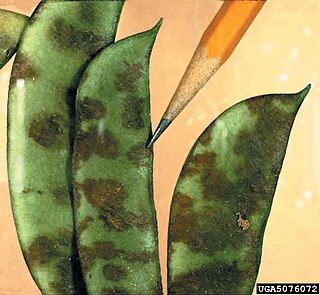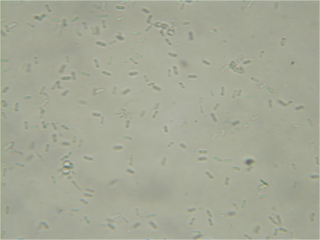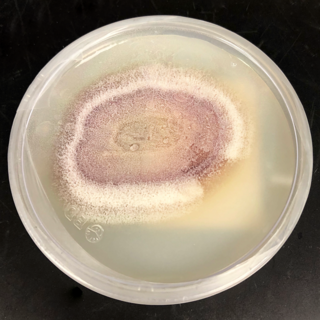
Septoria are ascomycete pycnidia-producing fungi that cause numerous leaf spot diseases on field crops, forages and many vegetables including tomatoes which are known to contract Septoria musiva from nearby cottonwood trees, and is responsible for yield losses. The genus is widespread, and estimated to contain 1072 species. Pycnidia produce needle-like pycnidiospores.

Botrytis cinerea is a necrotrophic fungus that affects many plant species, although its most notable hosts may be wine grapes. In viticulture, it is commonly known as "botrytis bunch rot"; in horticulture, it is usually called "grey mould" or "gray mold".
Forma specialis, abbreviated f. sp. without italics, is an informal taxonomic grouping allowed by the International Code of Nomenclature for algae, fungi, and plants, that is applied to a parasite which is adapted to a specific host. This classification may be applied by authors who do not feel that a subspecies or variety name is appropriate, and it is therefore not necessary to specify morphological differences that distinguish this form. The literal meaning of the term is 'special form', but this grouping does not correspond to the more formal botanical use of the taxonomic rank of forma or form.

Dothideomycetes is the largest and most diverse class of ascomycete fungi. It comprises 11 orders 90 families, 1300 genera and over 19,000 known species. Traditionally, most of its members were included in the loculoascomycetes, which is not part of the currently accepted classification. This indicates that several traditional morphological features in the class are not unique and DNA sequence comparisons are important to define the class.

Helotiales is an order of the class Leotiomycetes within the division Ascomycota. The taxonomy within Helotiales has been debated. It has expanded significantly as genomic techniques for taxonomical identification have become more commonly used. As of February 2020, the order is estimated to contain 30 accepted families, 519 genera, and 6266 species.

Colletotrichum is a genus of fungi that are symbionts to plants as endophytes or phytopathogens. Many of the species in this genus are plant pathogens, but some species may have a mutualistic relationship with hosts.

Stagonospora is a genus of fungi clustering in the Phaeosphaeriaceae (Quaedvlieg). Several of the species in this genus are plant pathogens.

The Pleosporales is the largest order in the fungal class Dothideomycetes. By a 2008 estimate it contains 23 families, 332 genera and more than 4700 species. The majority of species are saprobes on decaying plant material in fresh water, marine, or terrestrial environments, but several species are also associated with living plants as parasites, epiphytes or endophytes. The best studied species cause plant diseases on important agricultural crops e.g. Cochliobolus heterostrophus, causing southern corn leaf blight on maize, Phaeosphaeria nodorum causing glume blotch on wheat and Leptosphaeria maculans causing a stem canker on cabbage crops (Brassica). Some species of Pleosporales occur on animal dung and a small number occur as lichens and rock-inhabiting fungi.

Capnodiales is a diverse order of Dothideomycetes, initially based on the family Capnodiaceae, also known as sooty mold fungi. Sooty molds grow as epiphytes, forming masses of black cells on plant leaves and are often associated with the honeydew secreted by insects feeding on plant sap. This diverse order has been expanded by the addition of several families formerly thought unrelated and now also includes saprobes, endophytes, plant pathogens, lichens and rock-inhabiting fungi. The new additions include the genus Mycosphaerella containing the causal agents of several economically important crop and tree diseases. A small number of these fungi are also able to parasitise humans and animals, including species able to colonise human hair shafts.

Phoma is a genus of common coelomycetous soil fungi. It contains many plant pathogenic species.

Phaeoacremonium is a fungus genus associated with wilt and decline diseases of woody hosts and human infections.
Myrmecridium is a genus of fungi in the class Sordariomycetes. Circumscribed in 2007, it is distinguished from similar fungi by having entirely hyaline (translucent) vegetative hyphae, and widely scattered, pimple-shaped denticles on the long hyaline rachis. The generic name derives from a combination of the Ancient Greek word myrmekia, meaning "wart", and the suffix -ridium from Chloridium.
Campylocarpon is a genus of ascomycete fungi in the family Nectriaceae. The genus was described in 2004. The two species in the genus, C. fasciculare and C. pseudofasciculare, are associated with black foot disease of grapevines, in which the roots develop black, sunken, necrotic lesions.

Teratosphaeriaceae is a family of fungi in the order Capnodiales.

Stemphylium is a genus of fungal plant pathogen.
Ross Ewen Beever was a New Zealand geneticist and mycologist.

The Didymellaceae are a family of fungi in the order Pleosporales.

Cladosporium sphaerospermum is a radiotrophic fungus belonging to the genus Cladosporium and was described in 1886 by Albert Julius Otto Penzig from the decaying leaves and branches of Citrus. It is a dematiaceous (darkly-pigmented) fungus characterized by slow growth and largely asexual reproduction. Cladosporium sphaerospermum consists of a complex of poorly morphologically differentiated, "cryptic" species that share many physiological and ecological attributes. In older literature, all of these sibling species were classified as C. sphaerospermum despite their unique nature. Accordingly, there is confusion in older literature reports on the physiological and habitat regularities of C. sphaerospermum in the strict sense. This fungus is most phylogenetically similar to C. fusiforme. According to modern phylogenetic analyses, the previously synonymized species, Cladosporium langeroni, is a distinct species.
Ulocladium chartarum is an ascomycetes mushroom, one of the many in the genus Ulocladium.
Ulocladium botrytis is an anamorphic filamentous fungus belonging to the phylum Ascomycota. Commonly found in soil and damp indoor environments, U.botrytis is a hyphomycetous mould found in many regions of the world. It is also occasionally misidentified as a species of the genera Alternaria or Pithomyces due to morphological similarities. Ulocladium botrytis is rarely pathogenic to humans but is associated with human allergic responses and is used in allergy tests. Ulocladium botrytis has been implicated in some cases of human fungal nail infection. The fungus was first discovered in 1851 by German mycologist Carl Gottlieb Traugott Preuss.













